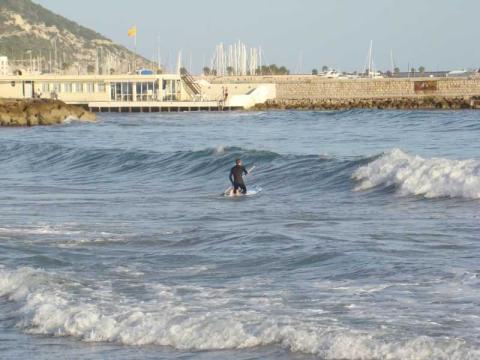During our Spain trip, we visited many interesting towns and places, like town of Girona, Salvadors Dali museum at Figueras, charming stone building town Peratallada, Begur, Roses and Cadaques and other. Now was turn for a popular resort town of Sitges, located close to Barcelona.
As usual I don't pay much attention for a new exploring object before visiting it - and it was fun latter to learn that Sitges is not only popular resort town in Spain, but it's a very popular destination for gay and lesbian travellers from all over the world. Well - quite an interesting fact about this town :)
I didn't pay much attention is there much gay/lesbian travellers (Seen some of them - like men kissing in the beaches and so on). What I found - Sitges probably is popular destination for surfers as well - seen pretty much surfers here (Maybe gay and lesbian surfers? )
No offense on LGBT people!
So did we stayed at a pretty nice hotel Globos at Sitges.
If honest, all those costal towns looks the same for me, but you may have other oppinion, so here are few pictures I did take in Sitges
Beach at Sitges
View to cathedral of Sitges
Boulevard at Sitges
Someone in rest at Sitges beach
Surfers learn to surf
View to Sitges from pier
Pier at Sitges
Rollers on the streets of Sitges town
About Sitges
Sitges is a town about 35 kilometres southwest of Barcelona, renowned worldwide for its Film Festival and Carnival.
Located between the Garraf Massif and the sea, it is known for its beaches, nightspots, and historical sites.
While the roots of Sitges' artsy reputation date back to the late 19th century, when Catalan painter Santiago Rusiñol took up residence there during the summer, the town became a centre for the 1960s counterculture in mainland Spain, then still under the dictatorship of Francisco Franco, and became known as "Ibiza in miniature".
Nowadays it is a popular destination for gay and lesbian travellers, as it has become one of the most gay-friendly places in the world.
Today, Sitges' economy is based on tourism and culture offering more than 4,500 hotel beds, half of them in four-star hotels. Almost 35% of the approximately 26,000 permanent inhabitants are from the Netherlands, the UK, France and Scandinavia, whose children attend international schools in the area. There are 17 beaches. Sitges was also the site of the annual Bilderberg conference held in June 2010.
Sitges has been referred to as the Saint-Tropez of Spain, with property prices approaching those of the most expensive European cities, the main reason for this being the setting by the sea and the surrounding Parc Natural del Garraf. Proximity to Barcelona-El Prat Airport is also a major advantage.
Human presence in the area dates to at least the Neolithic area, and an Iberian settlement from the 4th century.
In the 1st century BC it included two separated villages, later absorbed by the Romans. During the Middle Ages, a castle was built in Sitges, owned by the bishopric of Barcelona, which later ceded it to count Mir Geribert (1041).
In the 12th century the town fell under the rule of the Sitges family. The latter held it until 1308, when Agnes of Sitges sold the town to Bernat de Fonollar, after whose death it went to the Pia Almoina, a charitable institution, to which it belonged until 1814. Sitges' economy was mostly based on the production of wine until the economic boom of the 1960s, after which it became a tourist resort.
